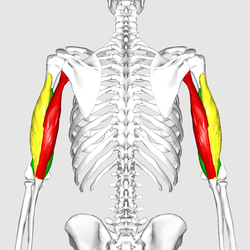Triceps
| Triceps Brachii | |
|---|---|

Triceps brachii seen from behind.
|
|

Triceps brachii seen from behind. Three different colors represent three different bundles which compose triceps.
Long head.
Lateral head.
Medial head.
|
|
| Details | |
| Origin |
Long head: infraglenoid tubercle of scapula Lateral head: above the radial sulcus Medial head: below the radial sulcus |
| Insertion | Olecranon process of ulna |
| Artery | Deep brachial artery |
| Nerve | Radial nerve and Axillary nerve |
| Actions | Extends forearm, long head extends,adducts arm, Extends shoulder |
| Antagonist | Biceps brachii muscle |
| Identifiers | |
| Latin | Musculus triceps brachii |
| TA | A04.6.02.019 |
| FMA | 37688 |
|
Anatomical terms of muscle
[]
|
|
The triceps brachii muscle (Latin for "three-headed muscle of the arm") is the large muscle on the back of the upper limb of many vertebrates. It is the muscle principally responsible for extension of the elbow joint (straightening of the arm).
The long head arises from the infraglenoid tubercle of the scapula. It extends distally anterior to the teres minor and posterior to the teres major.
The medial head arises distally from the groove of the radial nerve; from the dorsal (back) surface of the humerus; from the medial intermuscular septum; and its distal part also arises from the lateral intermuscular septum. The medial head is mostly covered by the lateral and long heads, and is only visible distally on the humerus.
The lateral head arises from the dorsal surface of the humerus, lateral and proximal to the groove of the radial nerve, from the greater tubercle down to the region of the lateral intermuscular septum.
Each of the three fascicles has its own motorneuron subnucleus in the motor column in the spinal cord. The medial head is formed predominantly by small type I fibers and motor units, the lateral head of large type IIb fibers and motor units and the long head of a mixture of fiber types and motor units. It has been suggested that each fascicle "may be considered an independent muscle with specific functional roles."
The fibers converge to a single tendon to insert onto the olecranon process of the ulna (though some research indicates that there may be more than one tendon) and to the posterior wall of the capsule of the elbow joint where bursae (cushion sacks) are often found. Parts of the common tendon radiates into the fascia of the forearm and can almost cover the anconeus muscle.
...
Wikipedia
